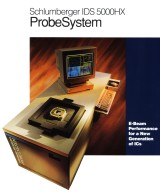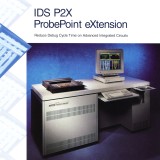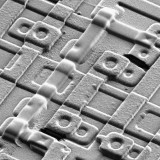Since
graduating from the University of
York in the UK with a B Eng (Hons) in Electronic Engineering,
James McLeod has spent most of his working life involved with Intergrated
Circuits (ICs or "Silicon Chips") and semiconductors in general.

This began even before his university
course started, when James McLeod had a summer placement job as a student.
He was given a project to write a software tool that could simulate the
test vectors used by a Schlumberger Sentry Series
20 ATE system and display them as a graphical waveform on a
monitor, rather than the 0s and 1s that the test engineers usually had
to work with. The results were so useful that the software was developed
further as the third year project for his Electronic Engineering degree,
so that the final program was able to understand not only the test vectors
but the compiled test software programs that used them too. Test engineers
could therefore carry out much of their program and development and debugging
off-line, using standard computers, rather than spending large amounts
of time on the ATE system, with its very basic editor and debug tools.
After completing his degree, James McLeod
went back to work on the Sentry Series 20, and wrote ATE software on the
system to test and characterise various different digital ICs. He also
developed the simulator software further, including converting the entire
sortware suite from VAX Pascal on VT340 Colour Graphics Terminals running
VAX/VMS to Turbo Pascal on Elonex 368SX PCs running Windows 3.0.
After a few years James McLeod finally
ended up running the laboratory, and as time went by the team acquired
more types of specialist equipment for characterising ICs, and the type
of work gradually became more varied.
The first major acquisition was an EBeam
prober system called an IDS 4000, which was replaced shortly afterwards
by a more sophisticated version, the IDS
5000HX. These systems were produced by Schlumberger and
in the early 1990s they revolutionised the debug process for new IC designs.
In simple terms, they are a low power (1keV) Scanning Electron Microscope
(SEM) which is able to image a device while it is operating, and acquire
a waveform from a signal track on the device by sampling the image information
at a given location. The software environment is simple and intuitive
for engineers to use, since the SEM image has an Oscilloscoe probe icon
which can be moved to the point of interest, and the waveforms acquired
are displayed on the screen as a virtual Oscilloscope tool. This allows
design engineers to look at the signals within their device and check
that the operation is as expected from their CAD simulation, and Failure
Analysis engineers can compare signals from Good and Bad devices to find
the location of a device failure. Although this had been possible in the
past, using mechanical microprobes, this is a slow and tedious process
with a significant risk of damage to the device from the probe needles.
The EBeam systems by comparison were a much better solution : waveforms
can be acquired from any visible signal track, with a resolution of better
than 1um, and because the process is completely contactless there is no
risk of damage to the device and the operation of the circuit is not affected
by the probing.

Once a design problem has been found,
the next logical step in the process is try out a possible fix to the
circuit to see if the correct operation can be achieved. Schlumberger
therefore developed a new product called the IDS
P2X. This is a Focussed Ion Beam (FIB) system, which uses
a beam of Gallium Ions and various different chemical gases to selectively
etch or deposit insulator or conductor. This provides the basic functionality
to be able to implement design fixes on the IC itself, by cutting and
reconnecting signal tracks, with resolutions of better than 1um. When
used in conjunction with an EBeam system, the two tools are a powerful
combination. A design problem can be identified on the EBeam, a prototype
fix can then be implemented on the FIB, and the modified device can be
put back in the EBeam to assess whether the fix has been successful.

The team acquired an IDS P2X system a
few years after the IDS 5000 HX, and these two systems have proved to
be invaluable in many aspects of their work. The FIB is an especially
versatile and useful tool, and has been used for almost ten years now
to assist dozens of semiconductor companies in resolving design problems
with their new devices. The IDS P2X only has a nominal minimum resolution
of 50nm, but so far James McLeod has been able to successfully carry out
FIB modifications on Metal 1 on devices with 8 layers of interconnect,
and on process geometries down to 0.13um. Although the IDS P2X was only
ever designed to work with Aluminium processes, he has also been able
to successfully carry out a number of FIBs on devices with Copper processes
too.

Some time later, the Sentry Series 20
tester was replaced by a newer Schlumberger ITS
9000 EXA Mixed Signal IC test system. This provided substantial
improvements in terms of speed, accuracy, and flexibilty across all aspects
of device test and characterisation. The ultra-stable liquid-cooled system
was derived from the ITS 9000 tester architecture originally developed
for Intel to allow comprehensive testing of their 486 and Pentium microprocessors,
which for the first time allowed test engineers the flexibilty to configure
tests with independent voltage and timing set-ups on every device pin
if necessary. The ITS 9000 EXA was the Mixed-Signal tester from this family,
which provided an integrated test solution for Digital, Mixed-Signal,
and Analog devices. It supported 200MHz data rates on up to 448 Digital
test channels, and up to four Analog measurement channels (any combination
of High Accuracy or High Frequency).
During his career, James McLeod has performed
test and design debug work for some of the biggest names in the electronics
industry, including Intel, Sony, Analog Devices, Alcatel, Maxim, Thomson,
and ST, plus dozens of smaller companies from all over the world (although
most of our customers have been based in the UK). If you have a design
debug problem with your latest IC, our EBeam characterisation and/or FIB
circuit edit capability might be able to help. For more information, please
contact James McLeod by email at jamesmcleod@mail2web.com